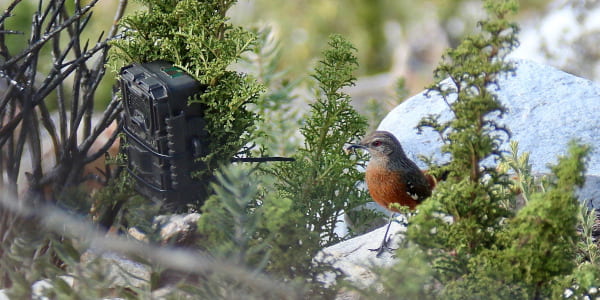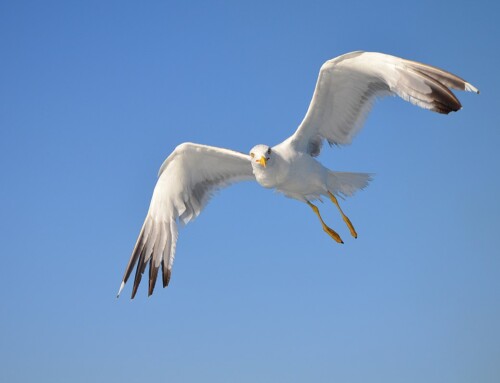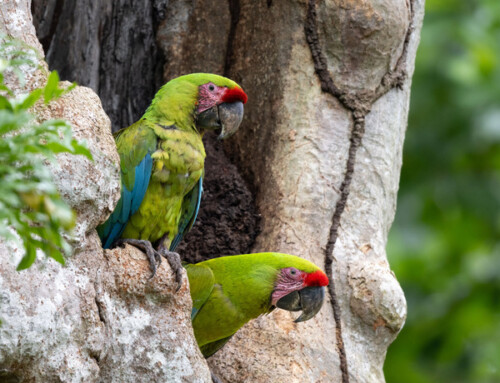LINKED PAPER
Increasing temperatures increase the risk of reproductive failure in a near threatened alpine ground-nesting bird, the Cape Rockjumper Chaetops frenatus. Oswald, K.N., Diener, E.F., Diener, J.P., Cunningham, S.J., Smit, B., & Lee, A.T.K. 2020. IBIS. DOI: 10.1111/ibi.12846. VIEW
Sometimes a bad field season can produce an incredible story. In 2017 I began monitoring nests of Cape Rockjumpers Chaetops frenatus during their breeding season (Aug-Dec) to determine how increasing temperature may be having detrimental effects on provisioning –– a key area of focus in part with the Hot Birds Research Project. Rockjumpers are a South African endemic to alpine fynbos whose populations have been shown to be declining in areas of their habitat experiencing the greatest warming (Milne, Cunningham, Lee, & Smit, 2015), and my PhD was based around trying to identify why. However, in 2017 I found it difficult to film provisioning when none of my nests survived until film day. Trail cameras from 2017 suggested predation levels were much higher than previously suspected (16 of 17 failed), and were predominantly due to a surprising predator, the Boomslang Dispholydus typus. While I had seen Boomslang around the field site, their eponymous name (Boomslang is “Tree snake” in Afrikaans) made them seem out of place in the scrubby alpine fynbos occupied by Rockjumpers.
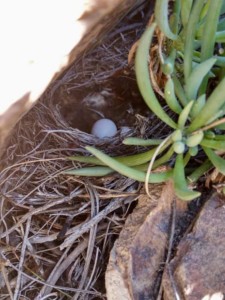
Figure 1 Rockjumpers build their cup nests under a rocky overhang, usually on a slight downslope side, with varying degrees of vegetative cover © Krista N Oswald
At the end of the 2017 field season myself and my co-authors from Rhodes University, FitzPatrick Institute of African Ornithology, and University of Kwa-Zulu Natal, took stock and realized the camera setup (placing trail cameras at every nest) would enable a fairly thorough examination of causes of predation. Motion sensitive photos informed us daily whether nests were active, and so were perfect for a nest survival analysis following Mayfield (1975). In particular, we would be able to look at nest failure in relation to concealment as Alan Lee had suggested John and Lizzie Diener (field assistants and expert nest-finders) collect metrics from each nest including vegetation cover. Then, a strange stroke of luck –– for us at least. In April 2017 wildfires had swept through most of southwest South Africa, including the northern section of our field site Blue Hill Nature Reserve. This newly denuded landscape had previously consisted of thick vegetation uninhabited by Rockjumpers. While we started noticing Rockjumpers move into the newly burnt areas by September 2017, we did not immediately take advantage of this phenomena, but did begin searching for nests in this area in 2018. We now had an additional factor which could affect nest survival, that being whether nests were in early post-fire habitat (burned in 2017), or late post-fire habitat (burned before 2017).

Figure 2 Top showing alpine fynbos which burned in 2012 with large boulders and low scrubby Restionacaea-dominated vegetation. Bottom showing old-growth fynbos with dense Proteacaea-dominated vegetation, not suitable for Rockjumpers, but with an oncoming wildfire which denuded the landscape in April 2017 and opened up new suitable habitat. Top photo © Krista N Oswald; bottom photo © Alan TK Lee
In total, we collected data from 54 nests over three years (2 ad hoc in 2016, 17 in 2017, 35 in 2018), with 46 nests failing. We examined daily nest survival in relation to fire, vegetation, and maximum daily temperature. While we were unable to identify specific predators at every nest (19 not identified), for the other 27 nests the main cause of predation was due to snakes (17 from Boomslang, 1 from Common Egg-eater Dasypeltis scabra).
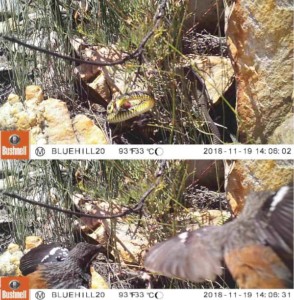
Figure 3 Top: Boomslang predation on a Rockjumper nest caught on trail camera. Bottom: male and female mobbing. While it may be that adults can deter Boomslang if they spot them in time, once Boomslang sense the nest they have never been successfully driven away
Contrary to past studies (Little, Hockey, & Jansen, 2015; Ricketts & Ritchison, 2000), we found no relationship between vegetative cover and survival. We did find increased survival in early post-fire habitat, possibly as birds benefit from increased habitat visibility allowing adults to spot potential predators from further off (as suggested by Götmark, Blomqvist, Johansson, & Bergkvist, 1995), or from recently burned areas having fewer predators. Throughout our study the greatest number of failed nests were due to snakes. These were almost exclusively Boomslangs (including one nest with two separate predation events, counted once in our main analysis) with this predation more likely at higher temperatures. Boomslangs are considered primarily arboreal predators, but their density in the fynbos may be underreported, partially from the difficulty of properly studying snake ecology due to their cryptic behaviour, habitat-use, and activity patterns (Siegel et al. 1987).
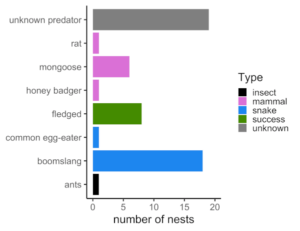
Figure 4 Fate of 54 Rockjumper nests. Totals include number of successful nests (‘fledge’) as well as failed nests. Failure was from predation by Boomslang, Cape Grey Mongoose Galerella pulverulenta, Honey Badger Mellivora capensis, unidentified rat species Otomys spp., Common Egg-eater Dasypeltis scabra, ants/starvation (‘ants’), or unknown predator
That nests had a higher probability of survival at cooler air temperatures indicates birds nesting earlier in the season (i.e. at cooler temperatures) have a higher chance of avoiding nest predation. However, we had two nests that failed due to late winter snow (not included in the analysis) suggesting this may come with increased risk of failure due to inclement weather. For our study, a disastrous 2017 season for breeding Rockjumpers suggested a need to study interactions between predators (especially snakes) and temperature, while fire ended up resulting in unexpected breeding success. Our findings emphasize the need for an integrative approach to assessing species vulnerability. While climate change will have many direct effects on reproductive success, it is also important for scientists to adapt and examine what initially are unexpected interactions. What may seem to be a disastrous field season can result in some incredible findings.
References
Götmark, F., Blomqvist, D., Johansson, O.C. & Bergkvist, J. 1995. Nest site selection: a trade-off between concealment and view of the surroundings? Journal of Avian Biology 26: 305-312. VIEW
Little, I.T., Hockey, P.A. & Jansen, R. 2015. Predation drives nesting success in moist highland grasslands: the importance of maintaining vegetation cover for bird conservation. Ostrich 86: 97-111. VIEW
Mayfield, H.F. 1975. Suggestions for calculating nest success. The Wilson Bulletin 87: 456-466. VIEW
Milne, R., Cunningham, S.J., Lee, A.T. & Smit, B. 2015. The role of thermal physiology in recent declines of birds in a biodiversity hotspot. Conservation Physiology 3: cov048. VIEW
Ricketts, M.S. & Ritchison, G. 2000. Nesting success of Yellow-breasted Chats: effects of nest site and territory vegetation structure. The Wilson Journal of Ornithology 112: 510-517. VIEW
Image credit
Featured image: A female Cape Rockjumper Chaetops frenatus bringing food for 5-day old nestlings at a nest in early post-fire habitat. Trail cameras were set up at every nest, allowing for daily updates on whether nests were active © Krista N Oswald



